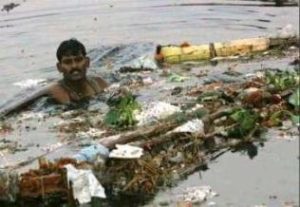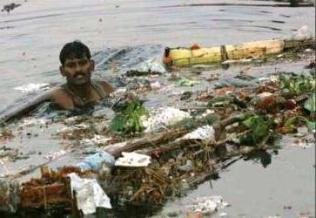New Delhi : The National Green Tribunal has directed the Delhi and Haryana governments to identify and address the sources of pollution in river Yamuna. The Delhi Jal Board (DJB), which supplies water to Delhi, had approached the tribunal demanding that Haryana be asked to take urgent steps to check the “dangerous level of ammonia” in river Yamuna. DJB contends that when the water enters Haryana, the ammonia level almost zero and very much treatable, whereas when the water enters Delhi, the level is very high.
On Feb 26, A bench headed by Justice Jawad Rahim ordered Central Pollution Control Board (CPCB) and Delhi Pollution Control Committee (DPCC) to ensure that action is taken against the erring industries responsible for causing pollution.
“Though, the issue is with regard to high level of ammonia in the water which is reaching the water reservoir of Delhi Jal Board, if you take the entire river eco-system, the pollution level in the portion of the river passing Delhi also needs to be properly checked.
“In the circumstances, we direct both, the State of Haryana and NCT of Delhi to ensure that they identify the source of pollution and address it appropriately. CPCB and DJB shall be involved to ensure the erring industry or local bodies and other parties who are causing pollution are dealt with appropriately and check the pollution level,” it said.
The tribunal also directed that the report submitted earlier by the CPCB with regard to pollutants needed to be rechecked with regard to pollution levels of ammonia downstream at Khojkipur drain No 2 and Khojkipur drain, as figures appearing in it appear to be incorrect.
The NGT had earlier directed the Delhi and Haryana governments to hold a meeting to resolve the issue of high ammonia content in the water being provided to the national capital.
Delhi Jal Board (DJB) had moved a plea in the tribunal plea alleging high ammonia in water being provided by the Haryana government to Delhi.
CPCB had submitted its analysis report of ammonia at Tajewala in Haryana, Wazirabad water treatment plant, Okhla and ITO barrage in Delhi.
According to the report, ammonia level at Hathnikund Barrage 0.6 mg per litre, 1.9 mg per litre at Wazirabad, 24.9 at ITO barrage on February 14 while at Okhla water treatment plant it was 0.8 mg per litre on February 15.
Acting on concerns over the health of the people of Delhi, the tribunal had directed the CPCB to analyse the samples of Yamuna water at the four points on DJB’s plea alleging high ammonia content in the water being provided by Haryana to Delhi.
While DJB had alleged that Haryana was supplying “poisoned sewage water” to the national capital which had 2.6 parts per million of ammonia, the counsel for Haryana had refuted the contention and said there was no breach of any agreement.
DJB, which supplies water to the city, had approached the tribunal demanding that Haryana be asked to take urgent steps to check the “dangerous level of ammonia” in river Yamuna.
Claiming that the water being released by the state was so polluted that it cannot be treated for drinking, the DJB had said it may cause “a huge and irreparable loss to the citizens of Delhi and has a potential for a grave health crisis and water crisis in the National Capital Region (NCR).”
The petition also claimed that when the water enters Haryana, the ammonia level is nil and very much treatable, whereas when the water enters Delhi, the level is very high.


